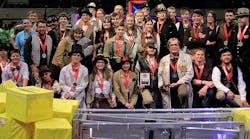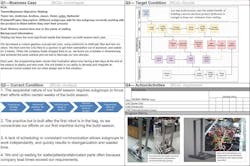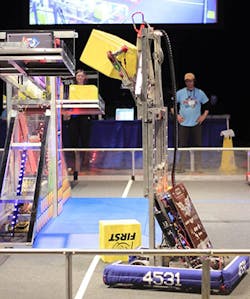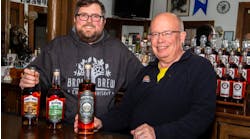How My High School FIRST Robotics Team STEMpunk Used Lean to Build a Winning Robot
For the last five years I’ve been part of a team of students named STEMpunk, building robots that compete in the global FIRST Robotics Competition. For four of those years our robots regularly ranked in the lower third of the 55-plus teams at our regional competitions. But this year, after our leadership group used lean methodology to transform the way we build robots, our machine ranked second overall at the regional in Lacrosse, Wisc. You could say our team completely agrees that our new lean management approach will be a constant feature in our future.
It all started with an internship opportunity last year. As part of our team’s relationship with our sponsor, Vollrath Company, I was hired to work with their manager of continuous improvement, Curt Knoll. Since Curt was studying an assembly line to establish operator balance, I spent many hours recording time study data and developing standard work documents. As I was spending my time in the Ohno circle, I learned to recognize waste and how it impacted productivity.
It didn’t take me long to realize our robotics team build process was flawed; not only did we hobble our productivity, bumping into the eight industry wastes at every opportunity, we did it unknowingly and without significant improvement from year to year. I imagined how our team could benefit from applying the powerful waste reduction tools Curt was teaching me, and set out to transform our team’s approach.
STEMpunk is run like a small business, with several student captains forming its management group. I needed to convince my fellow captains that applying lean manufacturing concepts to our robot build process would be a worthwhile effort. Each year we have six weeks to design, prototype, CAD, fabricate, assemble, wire, code, test and iterate a 120-pound robot. Year after year we have been limited by our schedule, and often downstream subteams such as the programming division get little time to deploy and test their code. After I promised my leadership team a potential 50% reduction in our lead time, I had all the buy-in I needed.
We set a strategy to implement lean with five initiatives in mind: 6S, value stream mapping, 8W waste reduction, flow production, and A3 documentation.
The Implementation
A 6S initiative was our first effort to implement lean manufacturing technique. We reorganized our stored premanufactured parts and raw materials such as electronics and extruded aluminum. Our toolbox drawers were foam boarded and streamlined to carry only the tools we used most frequently. Hand power tools were set up on a shadow board to establish a visual workplace that encouraged a standard of cleanliness. Our safety captain established standard responses to emergency situations and created a user-friendly SDS handbook, color-coded and streamlined for anyone to be able to quickly find what they need.
Next, value stream mapping allowed us to analyze our high-level process to identify waste and kaizen opportunities. As subteam captains, we were each process owners and qualified to suggest opportunities to eliminate waste. We understood our current state used all of our build season for the production of a single product with little room for testing or iteration. After several weeks of discussion, we laid out a future state VSM with an expected 50% reduction in lead time that would free up time for testing and improvement.
Each of our captains was put in charge of an A3 project on one of the eight industry wastes. The idea was to work through the ones that most frequently showed up in our VSM discussion, then move on to the less significant issues later. Waiting turned out to be our biggest waste as our linear build season only allowed for one subteam to add value to the product at a time. Our solution was to manufacture two identical products simultaneously, so we could juggle the products back and forth between subteams and maintain a high level of productivity. This change is illustrated in the following waste-reduction A3 document. The addition of a second identical product was also justified because it would help create higher-volume, lower-mix product families.
To hit our value stream goals, we needed to fabricate parts more efficiently. We were banking on establishing flow in the machine shop to produce at high volume. Our product runs are relatively high mix, but they share process steps. For example, a right angle bracket with four ¼ inch holes on one face and a square tube with two ¼ inch holes on either side are different parts, but they share a near identical fabrication process. We expected to create flow by balancing work content across these repeatable process steps, and running all the parts through the same line. We drafted a spaghetti map that helped us visualize the line, then added workstations and operators to balance higher work content process steps. We expected an average takt time of 4.5 minutes, but created both fast flow lanes and high load lanes to handle the variance in work content.
After designing the parts for the robot based on prototyping and CAD, we created drawing files of every part. This helped us estimate the work content based on the frequency of repeated processes and expected changeovers. We created a product family matrix based on this information and then scheduled the work content according to those families. Each work station had a work order packet that included a schedule and drawing prints of the parts it would be running. We expected some variance and barriers, so I handled the flexing of operators and work content throughout the product runs. Although many of the parts had total run times as long as 45 minutes, we machined 68 parts in five hours, averaging around 4.5 minutes per part, right on our goal.
The Returns
Every effort we undertook this year was documented for reference next year when we repeat the value stream and waste reduction process. These documents also came in handy when we presented to the judges at our regional competitions. In Duluth, Minn., we were recognized with the Engineering Inspiration award, the second most prestigious award in the competition. This qualifies us for the world championship in Detroit, and recognizes the impact our program has both on our own students and community.Ultimately, we hit many of our ambitious goals. Completing two identical products much earlier in our build season allowed us to test, iterate and improve the modules on the machine. Our linear elevator is currently in its third iteration while our pneumatic claw is in its fifth iteration. Our programming team was also able to tune our control system and develop extensive autonomous code that helps us get extra points. Our machine has performed admirably in both of our regional competitions, and we expect to be competitive at the world championship in Detroit.
The Future
Because lean helped us become competitive, we want to share these techniques and practices with other local teams. We are currently preparing a brochure to share with the other teams at the world championship. We will also be presenting to our sister team Droid Rage and other Manitowoc County teams. As we become more adept and established in lean practices, we expect to host workshops where we will invite Wisconsin teams to help them rework their process with lean.
Our FIRST robotics team, STEMpunk, in cooperation with an industry business supporting STEM education, The Vollrath Company, is growing respect and appreciation for lean methodology within the STEM education community. This is creating a talent pool of young future STEM professionals who will already be familiar with lean methodology before even working in industry. We hope that showing business professionals that high school kids are successfully implementing lean manufacturing tools in the production of robots will help inspire industries that haven’t already begun to adopt lean practices.
Ambrose Wiering is a home-schooled high school senior from Two Rivers, Wisc. He has been the business captain on his FIRST robotics team for the past four years. During this time, Wiering led several initiatives to grow STEM education within his community and mentored several youth robotics teams. Next fall Wiering will study mechanical engineering at the University of Alabama. There he will be part of the IGSEP Two Steps Ahead program, which that will allow him to study for a semester in Germany at the Hochschule Esslingen, University of Applied Sciences. In the future, Wiering hopes to be involved in both innovative product design and STEM education.






